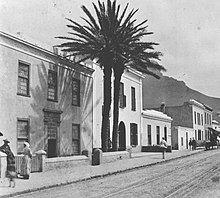
Johan Anthoniszoon "Jan" van Riebeeck was a Dutch navigator and colonial administrator who arrived in Cape Town in what then became the Dutch Cape Colony of the Dutch East India Company.

Potchefstroom is an academic city in the North West Province of South Africa. It hosts the Potchefstroom Campus of the North-West University. Potchefstroom is on the Mooi Rivier, roughly 120 km (75 mi) west-southwest of Johannesburg and 45 km (28 mi) east-northeast of Klerksdorp. Potchefstroom, together with Rustenburg, is the second-largest city in the North West Province. The largest city, Klerksdorp, is about 45 kilometres (28 mi) away.

Kirstenbosch is an important botanical garden nestled at the eastern foot of Table Mountain in Cape Town. The garden is one of ten National Botanical Gardens covering five of South Africa's six different biomes and administered by the South African National Biodiversity Institute (SANBI). Prior to 1 September 2004, the institute was known as the National Botanical Institute.

Uitenhage is a South African town in the Eastern Cape Province. It is well known for the Volkswagen factory located there, which is the biggest car factory on the African continent. Along with the city of Port Elizabeth and the small town of Despatch, it forms the Nelson Mandela Metropolitan Municipality.

Simon van der Stel was the last commander and first Governor of the Dutch Cape Colony, the settlement at the Cape of Good Hope.

Wynberg is a southern suburb of the City of Cape Town in Western Cape, South Africa. It is situated between Plumstead and Kenilworth, and is a main transport hub for the Southern Suburbs of Cape Town.

Emmarentia is a suburb of Johannesburg, South Africa.

The Bo-Kaap is an area of Cape Town, South Africa formerly known as the Malay Quarter. It is a former township, situated on the slopes of Signal Hill above the city centre and is a historical centre of Cape Malay culture in Cape Town. The Nurul Islam Mosque, established in 1844, is located in the area.
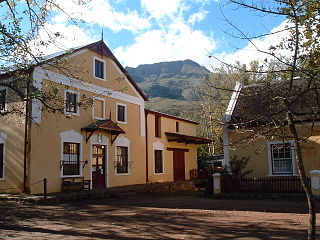
Genadendal[χəˈnɑːdəndal] is a town in the Western Cape province of South Africa, built on the site of the oldest mission station in the country. It was originally known as Baviaanskloof, but was renamed Genadendal in 1806. Genadendal was the place of the first Teachers' Training College in South Africa, founded in 1838.
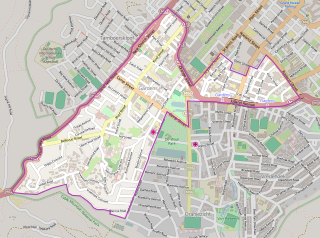
Gardens is an inner-city suburb of Cape Town located just to the south of the city centre located in the higher elevations of the "City Bowl" and directly beneath Table Mountain and Lion's Head. It is an affluent neighbourhood populated mostly by young professionals and contains numerous chic restaurants, hotels, boutique shops and loft apartments. The suburb is also a hub for the Cape Town creative industry, hosting the home of e.tv at Longkloof Studios and contains many modelling agencies, production and publishing companies and associated industries. It is also home to the world-famous five-star Mount Nelson Hotel.

Louis Michel Thibault, was a French-born South African architect and engineer who designed numerous buildings in the Cape Colony. He was South Africa's first trained architect and brought with him a distinctive mannered neo-classicism.
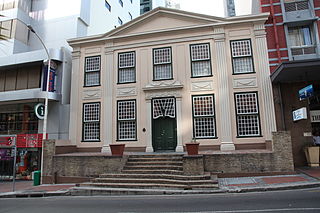
Koopmans-de Wet House is a former residence and current museum in Strand Street, Cape Town, South Africa. The house became part of the South African Museum in 1913 and was opened to the public on 10 March 1914. It was declared a National Monument under National Monuments Council legislation on 1 November 1940. It is the oldest house museum in South Africa.

The Auwal Mosque, alternatively spelled Awwal, Owal or Owwal, is a mosque in the Bo-Kaap neighbourhood of Cape Town, South Africa, recognised as the first mosque established in the country. It was constructed in 1794 during the first British occupation of the Cape on land belonging to Coridon van Ceylon, a Vryezwarten. Coridon's daughter, Saartjie van de Kaap, inherited the property that was being used as a warehouse, and donated it for the use as South Africa's first mosque. The mosque was constructed in 1794 with renovations done in 1907 and extensive renovations done in 1936. It is the first mosque to observe public prayers and is where Cape Muslim traditions and the Arabic-Afrikaans language were first taught. It remains a symbol for Muslims of the recognition of Islam and the freedom of slaves to worship.

George Museum is a cultural history museum located in the town of George, Western Cape, South Africa. It preserves the history of the town of George with a special focus on the timber industry. It also houses an art collection. The museum was started by Charles Sayers, in 1967 in a single room in Courtenay Street. The museum is now housed in the building the first magistrate, Adrian van Kervel built as the Drostdy (residency) from 1812 -1815.
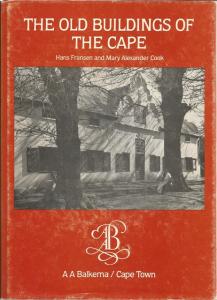
The Old Buildings of the Cape is a book by Hans Fransen, subtitled in its latest edition A survey of extant architecture from before c. 1910 in the area of Cape Town–Calvinia–Colesberg–Uitenhage. It lists extant and lost buildings and structures in the Cape Province of South Africa. First published in 1965 and since updated, the book is a widely recognised desk reference on the subject.

Stellenbosch Museum is a cultural history museum in the centre of Stellenbosch, South Africa. It was proclaimed a museum on 23 March 1962, and is a province-aided museum which receives support from the Government of the Western Cape. The museum includes four period houses which depict the way people lived and the difference in architectural styles over the periods illustrated. It also includes a historical powder magazine and a toy museum.

The South African Sendinggestig Museum was established in 1977 and is currently situated in the centre of Cape Town, Western Cape, South Africa. It is a province-aided museum which receives support from the Government of the Western Cape Province.

Belmond Mount Nelson Hotel is a luxury hotel at the centre of Cape Town in a garden estate overlooked by Table Mountain.

The Eerste Pastorie is an historic residence in Winburg in the Orange Free State of South Africa. The building was constructed in 1850 for the Dutch Reformed Church's pastor or predikant.
The Jamia mosque or Queen Victoria mosque is situated at the corner of Chiappini and Castle street, Cape Town. It is considered to be the first and oldest mosque in Cape Town, and the largest in the Bo-Kaap area of Cape Town.
